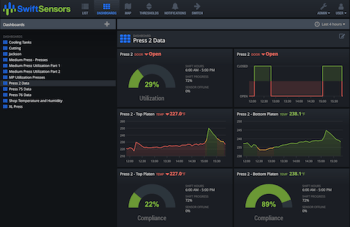Q&A with Sam Cece: On Developing an Easy-to-Deploy Wireless Sensor Solution
July 18, 2018
on
on
 Companies in every industry rely on low-energy wireless sensors for everything from equipment monitoring to people tracking. Unfortunately, developing, deploying, and maintaining a sensor network can be expensive and resource draining. Sam Cece explains how Swift Sensors addresses these issues with an easy-to-deploy, real-time sensor monitoring and tracking system.
Companies in every industry rely on low-energy wireless sensors for everything from equipment monitoring to people tracking. Unfortunately, developing, deploying, and maintaining a sensor network can be expensive and resource draining. Sam Cece explains how Swift Sensors addresses these issues with an easy-to-deploy, real-time sensor monitoring and tracking system.C. J. Abate: Tell us a bit about your background.
Sam Cece: Originally from Chicago, I moved to California to attend Woodbury University. After graduation I got my first job in Silicon Valley. I spent a significant amount of time at BEA Systems, where I had the role Global Services President, $400M in annual revenues, and more than 1000 employees across 26 countries. I was recruited from Silicon Valley to Austin to become CEO of Virtual Bridges, which was acquired by Nimboxx. I was CEO of CloudTools, which was acquired by SolarWinds. Finally, prior to Founding Swift Sensors, I was CEO of StrongMail Systems. StrongMail was named to the 2012 Forrester Wave Report shortlist.
C. J.: What inspired you and your cofounders to launch Swift Sensors in 2015? What was the main industrial IoT problem you were trying to solve?
Sam: My cofounder, Dean Drako, and I both have experiences where data from our operations was not available or easy to obtain and could have been used to improve our operations. My brother owns a restaurant in Chicago and has often asked for a more reliable temperature monitoring system for his coolers and freezers. Dean, while running Barracuda Networks, was frustrated with the lack of insight he got from his manufacturing operations.
C. J.: You sell a wide variety of sensor modules: temperature/humidity, acoustic/vibration, position, magnetic, and more. You have customers in industries such as food manufacturing and transportation. Where do see the biggest business opportunities in 2018?
Sam: Improving operational efficiency in manufacturing operations, particularly those operations with limited insights into the equipment efficiency. We also see a large opportunity in the production, delivery, and preparation of food, which encompasses the entire commercial chain from “farm to table.”
C. J.: Swift Sensors claims that its cloud wireless sensor system that can be configured and deployed at one-tenth of the cost of traditional systems. How do you keep this cost down?
Sam: The disruptive technologies of wireless sensors and cloud storage drive significant cost savings by obviating the need for costly sensor cabling and on-premise software data acquisition systems. With our cloud-based wireless system, the sensors can be installed in virtually any location. Additionally, there is no on-premise maintenance because the system is updated via the cloud, and any computer, tablet, or smart phone can access the system and data (Figure 1 and Figure 2).

Sam: Our system is designed as an end-to-end cloud-wireless system, giving our customers the best performance, security, reliability, ease of deployment. We do have an API so that sensor data can be easily extracted from our cloud storage and used for advanced analytics and custom reporting.

Sam: We have customers in a number of different industries: manufacturing, facility management, and hospitality. One that I find most interesting is an application of Meggitt Polymers and Composites. At their facility in Oregon, they produce many of the materials used in most of the world’s commercial airplanes. They have a number of presses and molding machines that have little or no data collection. With our wireless sensors monitoring activity and temperature, they have been able to determine their equipment efficiency over each shift and have already taken corrective actions to improve their production.

Sam: We are about to release a next generation of our sensor system that will improve our battery life and maximum distance between the sensors and the bridge. We’re also always adding new sensors. This month we just added air quality sensors for measuring ammonia and carbon monoxide. We continually update our Dashboard with customer requested features such as % Compliance and % Utilization analytics (Figure 3). We’ve recently added a major distribution partner, Iguazu, in Japan, and we will continue to develop channel partners throughout the world.
You can read the complete interview in the upcoming issue of Elektor Business (5/2018), which is slated for publication in September 2018.
Read full article
Hide full article



Discussion (0 comments)